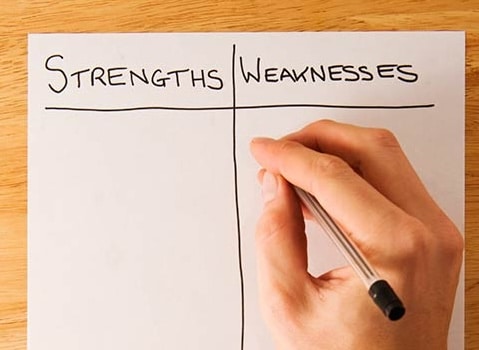How to Identify Your Strengths and Weaknesses
How do you accurately identify your strengths? How do you articulate them in a way that highlights your value? These are questions that many professionals grapple with. It’s not always easy to self-evaluate, especially when it comes to our strengths.
In this comprehensive guide, we aim to help you navigate this process. We’ll provide actionable insights and examples to aid your self-assessment. Whether you’re preparing for a performance evaluation, or simply seeking to understand yourself better, this guide is for you. By the end of this article, you’ll be equipped with the knowledge and tools to confidently discuss your strengths. You’ll also learn how to address your weaknesses without undermining your strengths.
The Importance of Self-Awareness in Performance Evaluations
Self-awareness is a critical component of performance evaluations. It’s the ability to understand your own strengths and weaknesses. It’s about knowing what you’re good at, where you can improve, and how your actions impact others.
This level of self-understanding is crucial in performance reviews. It allows you to present an accurate picture of your abilities. It also helps you identify areas for growth and development.
Moreover, self-awareness can enhance your professional relationships. When you understand your strengths, you can leverage them to contribute more effectively to your team. When you recognize your weaknesses, you can take steps to address them, preventing potential conflicts or misunderstandings.
Self-awareness also plays a key role in career progression. By understanding your strengths, you can align your career path with your abilities. This alignment can lead to increased job satisfaction and success.
In the following sections, we’ll guide you through the process of enhancing your self-awareness. We’ll provide practical steps and examples to help you identify your strengths and weaknesses. This will prepare you for your performance evaluation and contribute to your professional growth.
Preparing for Your Performance Evaluation: A Step-by-Step Guide
Performance evaluations can be daunting. However, with the right preparation, they can be a valuable tool for professional growth. Here’s a step-by-step guide to help you prepare:
- Conduct a self-assessment.
- Document your achievements.
- Seek feedback from peers and managers.
Conducting a Self-Assessment
A self-assessment is a critical first step in preparing for your performance evaluation. It involves taking an honest look at your strengths and weaknesses. This process can help you understand your performance from your own perspective.
Start by listing your key responsibilities and tasks. Then, evaluate your performance in each area. Consider your successes, challenges, and areas for improvement. Be honest, but also be fair to yourself.
Remember, the goal of a self-assessment is not to judge yourself harshly. It’s to gain a clear understanding of your abilities and areas for growth.
Documenting Your Achievements
Identifying your achievements is an important part of preparing for your performance evaluation. It provides concrete evidence of your strengths and contributions.
Start by listing your accomplishments over the review period. Include projects completed, goals achieved, and positive feedback received. Be specific and quantify your achievements where possible.
This documentation will serve as a valuable reference during your performance review. It will help you articulate your strengths and demonstrate your value to the team.
Seeking Feedback from Peers and Managers
Feedback from others can provide valuable insights into your performance. It can highlight strengths you may not be aware of and shed light on areas for improvement.
Start by asking your peers and managers for their feedback. Be open to their perspectives and take their comments into consideration. Remember, feedback is not personal. It’s a tool for growth and improvement.
By combining self-assessment, documentation of achievements, and feedback from others, you can prepare effectively for your performance evaluation. This preparation will help you present a balanced and accurate picture of your performance.
Identifying Your Strengths: Examples and Techniques
Identifying your strengths is a key part of preparing for your performance evaluation. It allows you to showcase your value and potential to your employer. But how do you identify your strengths? Here are some techniques:
- Reflect on your achievements.
- Consider feedback from others.
- Think about tasks you enjoy and excel at.
- Use self-assessment tools and personality tests.
Remember, your strengths are not just things you’re good at. They’re also things you enjoy doing and feel motivated to improve.
Common Professional Strengths
There are many types of professional strengths. Some common ones include:
- Communication skills: This includes both verbal and written communication. If you can express your ideas clearly and effectively, that’s a strength.
- Problem-solving skills: Involves the ability to analyze a problem and find a solution. If you’re good at thinking critically and making decisions, that’s a strength.
- Teamwork skills: This means working well with others to achieve a common goal. If you’re good at collaborating and building relationships, that’s a strength.
- Adaptability: It’s important to be flexible and able to adjust to changes. If you’re good at learning new things and dealing with uncertainty, that’s a strength.
Hard Skills vs. Soft Skills
In a performance evaluation, it’s important to consider both hard skills and soft skills. Hard skills are technical skills that are specific to your job. They include things like software proficiency, data analysis, and project management.
Soft skills, on the other hand, are interpersonal skills. They include things like communication, teamwork, and problem-solving. While hard skills can be learned through training and education, soft skills are often developed through experience and personal growth.
Both hard skills and soft skills are important for success in the workplace. By identifying and showcasing both types of strengths, you can present a well-rounded picture of your performance.
Recognizing and Addressing Weaknesses
Acknowledging your weaknesses is just as important as identifying your strengths. It’s not about focusing on the negative. Rather, it’s about understanding areas where you can improve. Here are some steps to help you identify your weaknesses:
- Reflect on challenges and setbacks.
- Consider feedback from others.
- Think about tasks you find difficult or avoid.
- Use self-assessment tools and personality tests.
Remember, everyone has weaknesses. The key is to acknowledge them and take steps to improve.
Examples of Areas for Improvement
There are many possible areas for improvement in the workplace. Some common ones include:
- Time management: If you often feel rushed or miss deadlines, you may need to improve your time management skills.
- Communication skills: If you struggle to express your ideas or understand others, you may need to improve your communication skills.
- Technical skills: If you lack certain skills required for your job, you may need to seek training or education.
- Emotional intelligence: If you struggle to understand and manage your emotions, or to empathize with others, you may need to improve your emotional intelligence.
Addressing Weaknesses in Your Review
When addressing your weaknesses in your performance review, it’s important to be honest but also positive. Don’t just list your weaknesses. Instead, discuss them in the context of your plans for improvement.
For example, instead of saying “I’m bad at time management”, you could say “I’ve noticed that I sometimes struggle with time management. I’m taking steps to improve this by using a planner and setting daily goals”.
This approach shows that you’re self-aware and proactive. It also turns a potential negative into a positive by focusing on your commitment to growth and improvement.
The Role of Feedback: Receiving and Acting on Criticism
Feedback plays a crucial role in identifying strengths and weaknesses. It provides an external perspective, which can reveal blind spots in our self-assessment. However, receiving criticism can be challenging. It’s natural to feel defensive or discouraged when faced with our shortcomings.
The key is to view feedback as a tool for growth, not as a personal attack. It’s an opportunity to learn and improve.
Tips for Receiving Critical Feedback Positively
When receiving feedback, try to keep an open mind. Listen carefully to what is being said, without rushing to defend yourself. Ask for clarification if something is unclear.
It’s also helpful to reflect on the feedback before responding. This gives you time to process the information and consider it objectively. Therefore, it’s okay to ask for time to think things over.
Creating a Personal Development Plan
Once you’ve received feedback, it’s time to create a personal development plan. This is a roadmap for how you will address your weaknesses and build on your strengths.
Start by setting clear, achievable goals. Then, outline the steps you will take to reach these goals. This might involve seeking training, practicing new skills, or seeking mentorship. It’s important to review and update your plan regularly as you make progress and as your goals evolve.
Leveraging Strengths and Weaknesses for Career Growth
Understanding your strengths and weaknesses is not just about improving your current job performance. It’s also about shaping your career path. By leveraging your strengths and addressing your weaknesses, you can open up new opportunities for growth and advancement.
Your strengths can guide you towards roles and tasks where you can excel. They can also help you stand out in a competitive job market. On the other hand, addressing your weaknesses can help you overcome barriers to your career progression.
Communicating Strengths and Weaknesses Effectively
Communicating your strengths and weaknesses effectively is crucial during performance reviews. When discussing your strengths, provide specific examples of how you have used these strengths in your work. This can help demonstrate your value to the organization.
When discussing your weaknesses, focus on what you are doing to address them. Show that you are proactive in seeking improvement and that you view your weaknesses as opportunities for growth, not as permanent limitations.
Continuous Learning and Adaptability
In today’s fast-paced work environment, continuous learning and adaptability are key strengths. They show that you are able to keep up with changes and that you are committed to your personal and professional development. Embrace these qualities and strive to cultivate them further.
Embracing a Balanced View of Your Performance
In conclusion, identifying your strengths and weaknesses is a crucial step in personal and professional development. It allows you to understand your capabilities, improve your performance, and shape your career path. It’s not about being perfect, but about understanding where you excel and where you can improve.
Embrace a balanced view of your performance. Celebrate your strengths, but also acknowledge your weaknesses. Use them as a roadmap for growth and development. With self-awareness, continuous learning, and adaptability, you can leverage your strengths and address your weaknesses to achieve your career goals.


